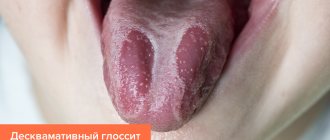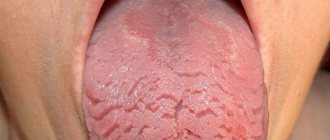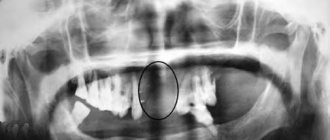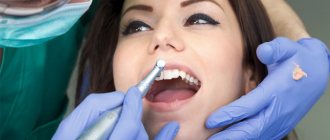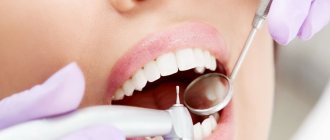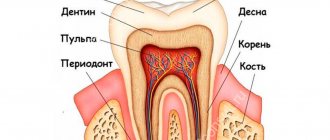What is glossitis?
What do we know about the tongue as an organ? We know that it is located in the mouth, which helps us articulate and pronounce words correctly, helps us mix food, feel all the diversity of existing tastes, that they can be shown indignation, and in some African countries, a demonstration of it can be used to declare war.
Such a significant number of different physiological and social functions may one day be compromised. And the name of this threat is glossitis.
Despite the absolutely clear location of this organ, there are big questions about which doctor deals with its problems: a dentist, gastroenterologist, maxillofacial surgeon or otolaryngologist. This is not an easy question, and sometimes you can endlessly go from one specialist to another. But let's finally understand this intriguing matter.
Causes of the onset of the disease
The following factors can cause the development of glossitis in adults:
- herpes virus that affects the mucous membrane;
- the presence of tartar, untreated caries;
- inflammation of the gums;
- poor oral hygiene;
- low immunity;
- burns;
- alcohol and smoking abuse;
- tongue injuries from sharp edges of fillings and teeth;
- allergies to certain foods or toothpaste components;
- overly spicy foods consumed on a regular basis.
The most common cause of glossitis in children is tongue biting. In addition, incorrectly selected braces, as well as a number of diseases (dermatitis, diabetes, the presence of worms) can provoke the disease. Often, children develop candidal glossitis, which looks like a white coating on the surface of the tongue.
Forms and types of disease
Inflammation of our organ of taste occurs frequently and does not always manifest itself with symptoms, proceeding completely hidden from us.
There are several forms and types of the disease:
- According to the duration, the disease is divided into acute (develops quickly and lasts no more than a month) or chronic glossitis (lasts more than a month);
- According to the form of the lesion, the catarrhal form (proceeding with redness and swelling) and the desquamative form (proceeding with a change in appearance) are distinguished;
- purulent forms - phlegmon and abscess (a purulent focus in the thickness of the organ tissue itself);
- a separate group includes neurological diseases of the nerves innervating this organ.
Cellulitis and abscess occur acutely, they are associated with infection and require urgent surgical intervention. They manifest themselves as severe pain, chills and swelling of the lymph nodes of the neck - this form can be confused with acute inflammation of the salivary glands, so diagnosis using ultrasound and x-rays is needed. It is better not to delay these symptoms and seek medical help as an emergency.
The catarrhal form of glossitis manifests itself with a sharp blood supply - the tongue swells, becomes bright red - this can manifest itself, for example, with scarlet fever, or an allergic reaction, which, in addition to the organ of taste itself, spreads to the soft palate with the tongue. Treatment in this case is aimed at eliminating the allergic reaction and inflammation.
The largest and most heterogeneous group is desquamative glossitis. It is difficult to list the number of factors (external, internal) that can provoke this form of the disease. We will not make a mistake if we say that “the tongue is the mirror of the digestive tract.” Since it contains many nerve receptors and papillae of different shapes and purposes (filamentous, cone-shaped, mushroom-shaped, leaf-shaped, groove-shaped), a change in each link of its anatomy outwardly reveals a hidden disease. Let's take a little look at the most common diagnostic signs of these conditions.
Treatment of glossitis
The choice of treatment tactics depends on the type of glossitis and the severity of symptoms. Some forms of the disease are completely harmless and do not require specific treatment. In this case, the doctor recommends dynamic observation.
The general principles of treatment for glossitis are presented as follows:
- maintaining oral hygiene;
- exclusion of traumatic factors (smoking, alcohol, eating hot, spicy and spicy foods).
- gentle diet for pain;
- prevention of secondary infection and inflammation;
- elimination of the disease that caused glossitis.
You should not treat glossitis at home without a doctor's advice. For infectious glossitis (bacterial, candida), the dentist will prescribe antibacterial or antifungal drugs, as well as local antiseptics. Taking these medications unwisely can make the situation worse.
Some forms of glossitis require surgery. For example, with rhomboid glossitis, the pathological focus can be excised using modern methods of surgical treatment, radio and laser surgery or cryotherapy.
For symptomatic (secondary) glossitis, it is necessary to treat the underlying disease. For example, glossitis in iron deficiency anemia requires the administration of iron supplements and the consumption of foods rich in this microelement. Without comprehensive treatment for the underlying cause, glossitis tends to persist. Treatment of such glossitis requires the collaboration of several specialists.
The prognosis for glossitis is favorable. Timely seeking medical help and following all doctor’s recommendations guarantee quick elimination of the symptoms of the disease.
Changes in appearance depending on the disease
One of the common types is “geographical tongue,” in which its upper surface resembles a map with the borders of countries and continents. This is the most common form of glossitis, which does not manifest itself in any way and does not require medical intervention unless complications arise (numbness, burning). This form occurs in waves, provoked by rough or spicy food, and hormonal cyclic changes. But the loss of the pattern of the papillae may indicate the presence of hypo- or hyperacid gastritis (that is, with increased or decreased acidity of gastric secretions) - such symptoms are typical for patients with gastroesophageal reflux, when hydrochloric acid and bile are thrown from the stomach into the oral cavity.
"Geographical language"
The second most common type of glossitis is a folded tongue. This is an independent type of glossitis. In this case, the back of the tongue seems to be riddled with deep cracks and it feels like there are folds in it. This form of glossitis sometimes accompanies neurological diseases (for example, Melkerson-Rosenthal syndrome) and is present in people with acromegaly (hormone-active pituitary tumor).
"Folded tongue"
Also characteristic are manifestations of various anemias, which are reflected in the appearance of the organ: iron deficiency anemia can manifest itself as a burning sensation on the tip of the tongue, the appearance of cracks on it and an erased pattern of taste buds. Pernicious anemia (B12 deficiency), in which the tongue has a “varnished” appearance with a smooth, swollen surface, sometimes quite painful, with burning symptoms, is the main cause of Gunther-Miller glossitis.
"Lacquered Tongue"
A large group of pathological conditions of this organ are ENT-associated symptoms associated with chronic tonsillitis - here the symptoms are non-specific, ranging from a dirty coating on the tongue to manifestations of diphtheria with white masses that are difficult to remove.
They also distinguish the formation of ulcers on the tongue - aphthous glossitis, which, as a rule, has a viral cause and goes away on its own. This is a recurrent disease, with more frequent episodes it is necessary to exclude pathology of the immune system.
When visiting a doctor, you will often notice pronounced teeth marks on the side of the tongue - a sign of long-term swelling. This occurs in patients with enterocolitis, kidney disease and cardiovascular diseases. The reason for this condition is water retention in the body.
Imprints from teeth on the lateral surface of the tongue
In the presence of abundant white plaque, accompanied by pronounced redness of the oral mucosa, one should suspect a fungal infection, often of a candidal nature. In this case, HIV must be excluded. Also with HIV, “hairy leukoplakia” occurs, when the tongue appears to have white hairs on the side surface, similar to flames - this condition is specific to HIV.
"White Hairy Tongue"
It is worth noting the existence of a “black hairy tongue”, which is a symptom of gastrointestinal disorders, less commonly a fungus.
"Black Hairy Tongue"
As you can see, our organ of taste reflects deep processes in the body, and it is difficult to single out one specialist responsible for its treatment. It is worth involving doctors of different spectrum in therapy, conducting studies based on data from smears and blood tests. But what general recommendations can we, as doctors, give to patients?
Causes of glossitis
All forms of glossitis have common properties. Any glossitis can occur due to a viral or bacterial infection. Glossitis often occurs due to mechanical trauma to the tongue, chemical and thermal damage. Glossitis may also indicate the presence of a concomitant disease or allergy in the patient’s body. Glossitis can also develop against the background of another oral disease.
The following are the most common causes of glossitis:
- damage to the tongue from sharp pieces of food or dentures;
- negative effects of hot water and food, thermal burns;
- insufficient oral care;
- smoking, alcohol abuse, poisoning with heavy metal salts;
- allergic reaction to toothpaste, mouthwash elements, orthopedic materials;
- the presence of herpes viruses, staphylococci, and yeast-like fungi in the body.
Glossitis can be a symptom of a general disease in the body. The most common cases of glossitis as a symptom of a concomitant disease are observed in the following diseases:
- infectious diseases (scarlet fever, measles and others);
- diseases of the gastrointestinal tract;
- blood diseases;
- hypervitaminosis;
- diseases of the oral cavity (especially stomatitis).
Also, different forms of glossitis can manifest themselves differently in different conditions of the body.
Care instructions
- Hygiene. We brush our teeth, but forget about our tongue. Thanks to advertising in the media, people are more likely to buy toothbrushes with a special brush for cleaning the tongue - and this is important. After all, bacteria live in the gap between the taste buds and food particles remain that must be removed from there.
- Caring for your oral health. Do not forget about the cleanliness of the palatine tonsils and the presence of reflux of gastric contents into the oral cavity.
- And the most important thing is to monitor your general health, undergo a timely examination by a doctor to identify the cause of inflammation - primarily to the dentist, but if you even consult a therapist or an infectious disease specialist, or an ENT doctor - you will not be mistaken, since there are almost no diseases, which would not affect such an important organ one way or another.
Prevention of glossitis
In order to prevent the occurrence of glossitis, it is necessary to exclude the causes that lead to the development of the disease. First of all, you need to closely monitor your health and promptly seek medical help when the first symptoms of any disease appear. You can also exclude exposure to traumatic factors, which include too hot food, spices and other products that irritate the mucous membrane. If the patient has malocclusion due to which the tongue is constantly injured, then it is necessary to consult a dentist and correct the problem.
Preventive measures
To avoid relapse of the disease, you should adhere to the following rules:
- do not neglect hygiene;
- do not allow dentures to cause discomfort and injure the mucous membrane of the tongue;
- regularly undergo preventive examinations at the dentist, remove dental deposits on time;
- promptly treat diseases that can cause the development of desquamative glossitis;
- adhere to a balanced diet;
- do not abuse too hot, cold, richly seasoned foods;
- stop smoking and drinking alcohol.
Localization of desquamative glossitis
The back of the tongue is characterized by an alternation of clear red-pink lesions of various shapes with a white border and a smooth surface devoid of papillae, which is why the tongue resembles a geographical map. Sometimes areas of desquamation have the shape of rings or semi-rings, they can be single, but more often they are multiple. Against the background of old lesions, new ones are formed, as a result of which the shape of the areas and color are constantly changing. This served as the rationale for the names “migratory” and “geographical” language.
In 40% of cases, desquamative glossitis is combined with a folded tongue.
Types of glossitis in adults
- Interstitial glossitis - occurs with syphilis, often leads to cancerous tumors of the tongue
- Gunterovsky - the initial symptom of pernicious anemia, manifests itself in the form of smoothing of the surface.
- Diamond-shaped tongue is a developmental anomaly.
- Folded is a congenital developmental anomaly.
- Hairy tongue - severe keratinization of filiform papillae, resulting in a black coating.
- Geographic (folded) - noticeable red spots, furrows.
- Ulcerative – bleeding ulcers and bad breath are observed.
- Catarrhal - a white dense coating covers the entire surface of the muscle.
Do not self-medicate, consult a doctor!
Don't wait for your condition to worsen!
Sign up
Answers on questions
What diagnostics are carried out before treatment?
The dentist examines the patient, collects medical history data: complaints, data on the patient’s general health (presence of chronic diseases). If necessary, laboratory diagnostics are prescribed: a smear (culture) from the oral cavity for microflora.
How to treat hairy tongue in adults?
The doctor prescribes complete sanitation of the oral cavity: removal of stone, plaque, and carious teeth. Selects individual home hygiene products. Prescribes a diet that includes plenty of fluids and solid vegetables. Smoking is prohibited. If necessary, the dentist prescribes rinsing solutions and antibacterial agents.
Forms of desquamative glossitis
Clinical forms of desquamative glossitis (A.I. Rybakov and G.V. Banchenko):
- Superficial
- Hyperplastic
- Lichenoid
Hyperplastic
Focal compaction of the papillae of the tongue, and in the area of their enlargement there are foci of white, yellow, gray color.
Lichenoid
The doctor can see areas of desquamation (peeling, flaking) of the epithelium of various shapes and sizes, where enlarged fungiform papillae are visible. Patients report a burning sensation. This form of glossitis occurs with increased sensitivity to dissimilar metals used in orthopedic structures (dentures, crowns, etc.), as well as in people suffering from neuroendocrine disorders
Geographic language
With the addition of secondary flora (fungi of the genus Candida)
